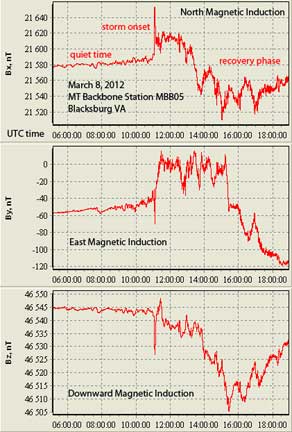Stormy Times Ahead: Impact of Solar Coronal Mass Ejection on Geomagnetic Field Detected by USArray
On Wednesday, March 7, a large solar flare ejected a massive stream of charged particles from the solar atmosphere. This "coronal mass ejection", or CME, was unusually strong, causing an increase in the background stream of particles emitted from the sun, known as the solar wind. By the following day, the trajectory of the CME brought it past the ACE (Advanced Composition Explorer) spacecraft, which detected the shock from the CME at 10:45 (Universal Time, or UT). The CME then came into contact with the Earth's magnetic field, where it set up a series of intense electric currents above the outer reaches of the atmosphere. These electric currents, whose intensity changes rapidly with time, induced electric currents to flow in the Earth and ocean. Researchers making use of EarthScope's USArray Magnetotelluric Observatory take advantage of these high altitude electric currents as a signal source.
For the first time investigators will be able to determine the 3D variations in the electrical conductivity of the crust and mantle on a truly continental scale. The conductivity of geologic formations is strongly related to the presence of fluids, including magma and brines, the composition and type of rock, its temperature, and the presence of minerals. The EarthScope Magnetotelluric Observatory, through a subcontract from IRIS to Oregon State University, and with the collaboration of investigators across the US, maintains seven permanent stations (installed in Oregon, California, Montana, New Mexico, Missouri, Minnesota and Virginia) and operates a movable array of temporary stations that are systematically mapping out the electrical conductivity structure of the crust and mantle across the continental US on a 70-km spaced grid of observation stations.
 |
| The Earth's magnetic field recorded at the permanent EarthScope Magnetotelluric Observatory Station MBB05, located near Blacksburg, Virginia, on March 8, 2012 (times are in Universal Time). The Earth's magnetic field varies with direction, and at Blacksburg, the field is strongly inclined downward from the horizontal and oriented toward the magnetic north pole. The top panel shows the intensity of the magnetic field as measured in the magnetic north direction, plotted in magnetic induction units of nT (nano Tesla). The middle panel shows it as measured in the magnetic east direction, and the bottom panel shows the field intensity measured vertically downward. The total intensity of the Earth's magnetic field at Blacksburg is about 51,000 nT. (Figure courtesy of Dr. Chester Weiss, Virginia Tech University, Blacksburg, VA). |
It appears that the Earth dodged the full force of this massive CME. The Sun's tendency to emit CMEs follows an approximately 11-year solar cycle. The low point of the current cycle was in late 2009-early 2010; geomagnetic storm activity was at historically low levels for at least three years before that. While the EarthScope Magnetotelluric Observatory network depends on such storm activity to provide signals to probe the Earth's electrical conductivity structure, improvements in instrumentation and data processing tools have made it possible for EarthScope to obtain magnetotelluric data of extremely high quality despite the low signal levels. With the solar cycle projected to peak in early 2014, and to remain high for several years after, large CMEs and geomagnetic disturbances lie ahead. These stormy times mean even smoother sailing for the magnetotelluric program as signal levels pick up and data quality gets even better.
For more information contact: Dr. Adam Schultz, EarthScope Magnetotelluric Observatory Project Manager, Oregon State University (adam@coas.oregonstate.edu).


